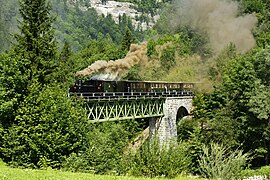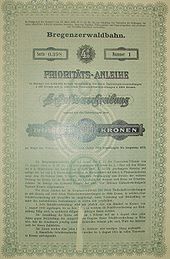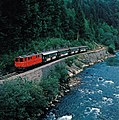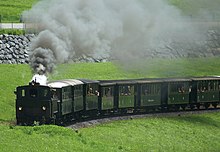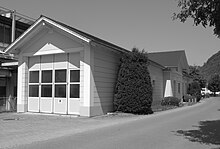Bregenz Forest Railway
| Bregenz – Bezau | |||||||||||||||||||||||||||||||||||||||||||||||||||||||||||||||||||||||||||||||||||||||||||||||||||||||||||||||||||||||||||||||||||||||||||||||||||||||||||||||||||||
|---|---|---|---|---|---|---|---|---|---|---|---|---|---|---|---|---|---|---|---|---|---|---|---|---|---|---|---|---|---|---|---|---|---|---|---|---|---|---|---|---|---|---|---|---|---|---|---|---|---|---|---|---|---|---|---|---|---|---|---|---|---|---|---|---|---|---|---|---|---|---|---|---|---|---|---|---|---|---|---|---|---|---|---|---|---|---|---|---|---|---|---|---|---|---|---|---|---|---|---|---|---|---|---|---|---|---|---|---|---|---|---|---|---|---|---|---|---|---|---|---|---|---|---|---|---|---|---|---|---|---|---|---|---|---|---|---|---|---|---|---|---|---|---|---|---|---|---|---|---|---|---|---|---|---|---|---|---|---|---|---|---|---|---|---|---|
|
A steam train on the Sporeneggbrücke
| |||||||||||||||||||||||||||||||||||||||||||||||||||||||||||||||||||||||||||||||||||||||||||||||||||||||||||||||||||||||||||||||||||||||||||||||||||||||||||||||||||||
| Route number (ÖBB) : | 915 01 | ||||||||||||||||||||||||||||||||||||||||||||||||||||||||||||||||||||||||||||||||||||||||||||||||||||||||||||||||||||||||||||||||||||||||||||||||||||||||||||||||||||
| Course book route (ÖBB) : | ex 43a | ||||||||||||||||||||||||||||||||||||||||||||||||||||||||||||||||||||||||||||||||||||||||||||||||||||||||||||||||||||||||||||||||||||||||||||||||||||||||||||||||||||
| Route length: | 35,302 km | ||||||||||||||||||||||||||||||||||||||||||||||||||||||||||||||||||||||||||||||||||||||||||||||||||||||||||||||||||||||||||||||||||||||||||||||||||||||||||||||||||||
| Gauge : | 760 mm, up to km 1.58 also 1435 mm | ||||||||||||||||||||||||||||||||||||||||||||||||||||||||||||||||||||||||||||||||||||||||||||||||||||||||||||||||||||||||||||||||||||||||||||||||||||||||||||||||||||
|
|||||||||||||||||||||||||||||||||||||||||||||||||||||||||||||||||||||||||||||||||||||||||||||||||||||||||||||||||||||||||||||||||||||||||||||||||||||||||||||||||||||
The Bregenzerwaldbahn , also popularly Wälderbahn or Wälderbähnle called, is a Austrian narrow-gauge railway with a track width of 760 millimeters, the so-called Bosnian gauge . It is located in the federal state of Vorarlberg and connected Bregenz on Lake Constance with Bezau in the Bregenz Forest on a 35.302 kilometer stretch from 1902 to 1983 . Today only a 5.01 kilometer long section is still in operation as a museum railway , the rest of the route has been closed and dismantled.
history
planning
Until the end of the 18th century, only mule tracks were available for transporting goods in and out of the Bregenzerwald, and then the first paths for carriage traffic. Another important means of transport was the wild mountain river Bregenzer Ach itself, the flood of which "carried" the felled and delaminated logs from the Bregenz Forest to Bregenz. Far-sighted personalities saw the spread of rail traffic as the ideal means of transport also for the valleys of the Bregenzerwald. They expected "advantages for industry, trade and tourism, an increase in the value of the land, an increase in the number of livestock and better employment opportunities for local workers" . The "loss of timber transport on the Bregenzerache should also come to an end" .
As early as 1864, three years before the Lindau – Bludenz railway line was opened , district forester Johann Koderle from Bezau suggested a horse-drawn railway from Bregenz to Au.
However, the Bregenzerwald population behaved cautiously. In 1871, a very detailed railroad project was rejected because of doubts about the economic viability in a popular assembly. In 1891 a consortium then submitted a new application, which was finally granted in August 1899 with the concession to build and operate the narrow-gauge local railway from Bregenz to Bezau.
Routing
The route led from the train station of the Vorarlberg state capital Bregenz through the suburb of Rieden to Kennelbach. From here the route ran 19 kilometers through the narrow valley of the Bregenz Ach . Apart from the railway, there was no other transport connection along the river. The high-lying villages were several kilometers away from the train stations and sometimes only connected by paths and footpaths. To connect the municipality of Buch on a terrace to the west of the Bregenzerach, two suspension bridges were even built over the river to the Doren-Sulzberg train stations (still preserved today) and Langen-Buch (only remains of ruins).
It was not until Egg that the line reached the revitalized area and led via Andelsbuch through the Bersbucherwald to Schwarzenberg station (today the start of the museum railway) and on to Bezau. From 1910 to 1914 an extension of the railway to Schoppernau was planned , but could not be realized because of the outbreak of the First World War .
Train under the Lingenau high bridge , around 1970
construction
May 25, 1900 was the founding day of the private stock corporation Bregenzerwaldbahn (BWB) and on September 7, 1900 the groundbreaking ceremony took place at the "Riedener Tunnel". Master builder Johann Bertolini took over the management of the construction of sections such as the Andelsbuch- Bersbuch line and some bridges. The workers came from Trentino, Slovenia, Croatia and Hungary.
During the construction period, a flood destroyed most of the new buildings in the Achtal, which caused the construction company employed there to go bankrupt. It was only after a considerable delay, in April 1902, that construction work began again and then, on September 15, 1902, the line was opened fairly quickly. Shortly before that, the kk Post and Telegraphendirektion Innsbruck had published a timetable for the Bregenzerwaldbahn.
business
The kk Österreichische Staatsbahnen was entrusted with the operational management ; in the first few years four locomotives of the U series were available as locomotives . During the First World War, several vehicles were handed in for military service, some of which did not return. In 1932 the license for operation was transferred to the Austrian Federal Railways (BBÖ), today's Austrian Federal Railways (ÖBB).
In the first few years, the railway brought the region the desired economic upswing. In 1936, after 34 years, the first application to discontinue the railway was tabled, which was rejected with a reference to the lack of alternative road connections. In 1937, the first diesel locomotives of the BBÖ 2041 / s series (later ÖBB 2091) gradually replaced the previous steam locomotives in order to make the traction more economical.
In the first Austrian republic , the line belonged to the area of responsibility of the Innsbruck Federal Railway Directorate . After Austria was annexed in 1938, it operated briefly as the Innsbruck Railway Directorate before it was dissolved on July 15, 1938. The line was subordinated to the Reichsbahndirektion Augsburg . After 1945 the ÖBB was re-established, the management structure from the time before 1938 was re-established, including the Innsbruck Federal Railway Directorate.
From the 1960s, the then newly acquired locomotives of the ÖBB class 2095 were used. They should bear the brunt of the traffic until the route is closed. In 1974, steam operation returned to the Bregenzerwaldbahn. With the support of the Swiss organization EUROVAPOR , a nostalgic operation was started with a steam locomotive from the Zillertalbahn , later followed by a 699 , which was rented by the Club 760 association . These nostalgic trains were a complete success and brought the Wälderbahn, which at that time was already at risk of recruitment, urgently needed additional income.
Operational difficulties
The route through the partially gorge-like narrow valley of the Bregenz Ach turned out to be a major problem. Time and again, landslides , rockfalls and destruction by floods led to line interruptions and thus reduced the railway's economic results. The stations in this section of the route were also located far away from the associated towns; only from Egg were they conveniently located to the town centers.
attitude
“On April 21, 1980, the train service was stopped because the Rotach Bridge was undermined. From June 16, passenger and freight traffic was resumed on the entire route. Exceptionally long-lasting rainfall in the summer months caused a landslide on July 3, 1980 at 7.45 kilometers. As a result, the route between the Kennelbach and Egg stations was interrupted until July 5th. On July 14, another landslide of around 6000 cubic meters occurred at km 7.1. A replacement rail service has been set up between the Kennelbach and Egg stations. The clean-up work in the Achtal has started. However, on August 13th this work was stopped because the earth masses began to slide at the same point. This sealed the fate of the Kennelbach-Egg route. "
In October of the same year, the remaining island operations between Egg and Bezau and in 1983 the rest of the entire traffic from Bregenz to Kennelbach was given up.
An authorization by the Vorarlberg state governor brought the railway to an official halt on January 29, 1985. Shortly afterwards, the first tracks began to be removed in individual sections.
Museum train
In 1985 the Bregenzerwaldbahn- Museumbahn association was founded in order to maintain the route at least in parts and to continue to operate it in museum operations. However, the original vehicles had all been removed, which is why operations in 1987 could only be opened from Bezau to Schwarzenberg station with rolling stock procured from other routes, including a rearranged sidecar of the Stubaitalbahn . The first locomotive was a truck converted into a rail vehicle, some smaller diesel locomotives, including the Heeresfeldbahnlokomotive (HF130C) now known as "Hilde", which came from the Payerbach – Hirschwang local railway and was there as D1 until it was discontinued on August 12, 1982 was in use, and more Stubaitalbahn wagons were purchased in the following years. Another section could also be reactivated up to the Bersbuch stop.
As the museum's first steam locomotive, the former 798.101 "Nicki S." was used on loan in the early 1990s , after it had previously become unemployed due to the discontinuation of the Jagst Valley Railway on its main line. Since 1993, the U.25, a reconditioned original steam locomotive of the U series of the Bregenzerwaldbahn, has been operational again, in 2001 a second steam locomotive followed with a Uh . The necessary passenger cars were rebuilt on the chassis of freight cars. The Whitsun flood of 1999 brought the Sporenegg Bridge to collapse, which was reopened in June 2000 after a new construction. The Alpine floods in 2005 also caused damage to the railway line by washing under the track and flooding the Bezau train station, but these could be repaired within a few weeks.
The museum is now operating on the rest of the Bezau – Schwarzenberg route; an extension to Andelsbuch or further to Egg has already been discussed several times. However, from October 2004 exactly the opposite occurred. The route was shortened by 1.1 kilometers (new terminus in Schwarzenberg) because the railway line between Schwarzenberg and Bersbuch had to be given up for a road construction project. Furthermore, the association had to withdraw from some properties at the Bezau train station on which a supermarket was built. To replace the old boiler house, a new vehicle and workshop hall was built; instead of a switch, a segment turntable was installed at the new end of the line to make optimal use of the remaining space .
Re-use of the route
Andelsbuch train station is used as a cultural event location, next to which the Bregenzerwald workshop now has an impressive exhibition building, designed by Peter Zumthor . The route between Andelsbuch and Egg was expanded into a cycle path in 1992, which has led via Lingenau to Doren since 2013. Official and unofficial re-uses, such as via ferratas on bridges or works of art on trees, were discovered, exhibited and described in several reports in 2014 by students from the Vorarlberg University of Applied Sciences .
Most of the route between Kennelbach and Bregenz has been converted into cycle paths. All three tunnels on the route are in good condition, having just before the shutdown were not rehabilitated. The Riedentunnel (212 m) is very popular with cyclists despite its incline. From here, until shortly before the Bregenz train station, the route has almost completely disappeared. Just a gatekeeper's house, which is now used as a snack, is evidence of the Bregenzerwaldbahn. The three- rail track , which was also electrified until shortly before the Riedentunnel, was dismantled. The standard-gauge tracks of this section could be seen well into the 2000s up to the former Remise Rieden. In this remise, which is now used as a workshop by a youth institution, short sections of the Bregenzerwaldbahn track have been preserved.
In 2011, the traffic planning department of the state of Vorarlberg commissioned a study to find out which realignments are sensible and possible and which sections of the route could be reactivated. Here, the variant was also examined that leads from Dornbirn via the city hospital to Gütle and would extend as an eight-kilometer tunnel to Bersbuch and on the route still used by the museum railway to Bezau and on to Schoppernau . Another tunnel would take you to the Kleine Walsertal , which is part of Vorarlberg , but can only be reached from there via a several-hour walk.
On August 30, 2016, the Vorarlberg Federation of Industrialists presented a combination of a rail and cable car solution that will lead over the Hochälpele.
- Wälderbahn song
The popular “Fahr 'ma no' a klele” (“Let's go a little longer”) song was written about the forest railway. It was quite common for songs to be composed about narrow-gauge railways. The song is still known to children and adults in the Vorarlberger Unterland and the Bregenzerwald today.
Incidents
On January 11, 1965 at 7:02 p.m. the evening train (train number 7311, 6:15 p.m. from Bezau) between Egg and Lingenau / Hittisau, shortly after Egg, in front of the Tuppenbrücke (road bridge) crashed into the rubble of a rock fall. The diesel locomotive 2095.05 fell 30 meters and came to stand upright in the river bed of the Bregenzerache. The engine driver was seriously injured. The following post car got stuck on the slope on the retaining wall because the coupling to the locomotive broke. The three passenger cars attached behind them remained derailed, but hardly damaged on the tracks. The locomotive was repaired and was back in service (at least) until October 1980.
On September 10, 1965, the train from Bezau to Bregenz (departure Bezau at 6:17 p.m.) was attacked. A lone perpetrator, around 22 years old, broke open the door to the post car, which contained more than a million Austrian schillings (income from the post offices in the Bregenzerwald, which were transported to Bregenz every 10th of the month) and grabbed the post office officer in the car two knives. After a fight in which both men were seriously or critically injured (the post office clerk with 18 cuts and stab wounds), the perpetrator fled without prey. Near the Rickenbach tunnel, at km 9.3 at 7:34 p.m., the post officer was able to trigger the emergency brake and call for help. The search for the perpetrator has remained unsuccessful to this day. The same post office worker was also in the post van that narrowly escaped a crash in the Bregenzerache on January 11, 1965.
Literature, video
- Karl Blodig : The Bregenz Forest Railway . In: Heinrich Hess (Red.): Communications of the German and Austrian Alpine Club , No. 12/1902 (XXVIIIth year), Munich / Vienna 1902, p. 143 f.
- Markus Rabanser, Martin Hebenstreit: The Bregenzerwaldbahn. The story of a railroad or "d 'Zuokumpft rumplot with G'wault therefore" . (Second edition). Hecht, Hard 1990, ISBN 3-85430-106-5 .
- Krobot, Slezak, Sternhart: Narrow-gauge through Austria. History and fleet of narrow-gauge railways in Austria, 327 photos, 1063 vehicle sketches, 23 route plans, 36 station plans, 11 type drawings . (4th edition). Slezak, Vienna 1991, ISBN 3-85416-095-X .
- The Bregenz Forest Railway . 1 video cassette (VHS, PAL), 40 minutes. SR Film & Video Filmproduktionsgesellschaft, Rosental 1994, OBV .
- Lothar Beer: A railway in the rhythm of time. - The history of the Bregenzerwald Museum Railway . Hecht, Hard 2007, ISBN 978-3-85298-147-5 .
- Norbert Fink: The Bregenzerwaldbahn 1902 to 1983 . Sutton, Erfurt 2009, ISBN 978-3-86680-442-5 . (Commentary and press release online ).
- Johann Karl Heribert Koderle, memorandum on population, property and traffic conditions in the Achthal railway area , Bregenz 1871, self-published ( google books ).
- Norbert Fink and Peter Balmer: The Bregenzerwaldbahn - yesterday and today . Sutton, Erfurt 2020, ISBN 978-3-96303-148-9
Web links
- Website of the Bregenz Forest Railway Association - Museum Railway
- Thomas Hammerer: The Bregenzerwaldbahn - in the past - today . Comprehensive documentation of the Bregenzerwaldbahn.
- Reiner Schruft: Bregenz-Bezau at Forgotten Railways . State 2009 arranged according to 6 sections.
Individual evidence
- ↑ a b c see web link to the archive of the Bregenzerwaldbahn-Museumsbahn association
- ↑ a b c Information board about the history of the Bregenzerwaldbahn in the disused Doren-Sulzberg station in Bozenau
- ↑ Deutsche Reichsbahn-Gesellschaft (Ed.): Official Gazette of the Reichsbahndirektion Mainz of August 6, 1938, No. 36. Announcement No. 488, p. 213.
- ↑ in Vorarlberg the representative of the governor
- ^ Re- use of the route on the Bregenzerwaldbahn website earlier-today
- ↑ Report "Interpretations"
- ↑ The Bregenz Forest Railway - in the past - today. Retrieved October 7, 2018 .
- ↑ Blog entry on a new route, accessed on March 26, 2014
- ↑ "Wälderbahn": cable car project into the forest, ORF Vorarlberg report accessed on August 31, 2016
- ↑ Daniela Mathis: Bregenz Forest: Drive 'ma no' a klele! In: DiePresse. August 22, 2017. Retrieved August 6, 2019 .
- ↑ a b The Bregenzerwaldbahn - then - now - the locomotives. Retrieved June 5, 2020 .
- ↑ Thomas Feurstein: Tatort: Km 9.3 , Vorarlberg topic, issue 49, June 2019, p. 46.
- ^ Post officer attacked by the Bregenzerwald Railway , Vorarlberger Nachrichten of September 11, 1965.
Coordinates: 47 ° 22 ′ 55 " N , 9 ° 53 ′ 45" E
